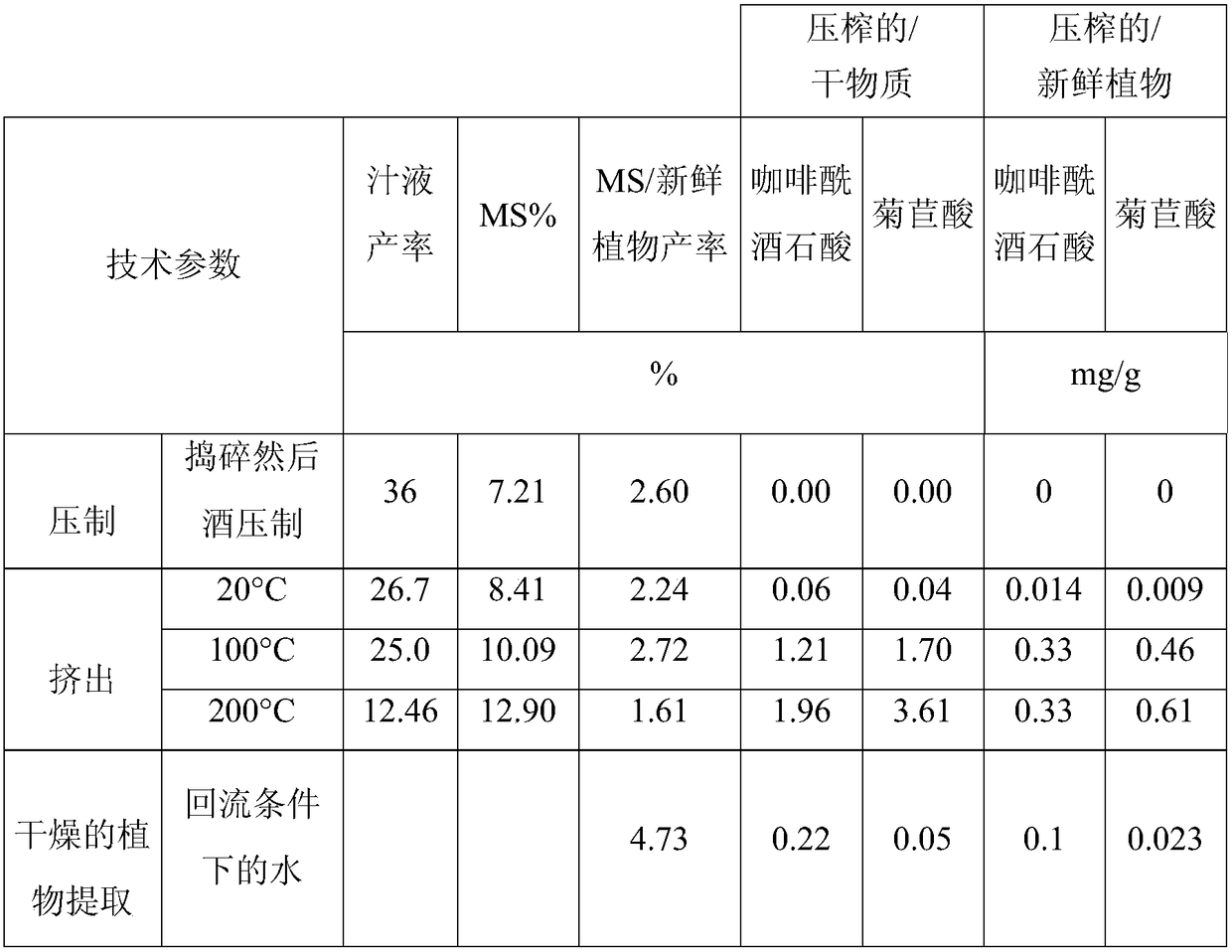Obtaining sap of fresh plants and their cosmetic and therapeutic uses by thermothermal treatment
A deformation heat treatment, plant technology, applied in cosmetics, cosmetic preparations, medical raw materials derived from angiosperms, etc., can solve the problem of not mentioning deformation heat treatment, etc.
- Summary
- Abstract
- Description
- Claims
- Application Information
AI Technical Summary
Problems solved by technology
Method used
Image
Examples
Embodiment 1
[0087] After a growth period of 2 months (oat seedlings), 12.75 kg of unfrozen (24 h at 2° C.) fresh above-ground parts of oats (Avena sativa L.) harvested by harvester were fed into The first barrel of a five-barrel twin-screw extruder with rotating, co-rotating osmotic screws—CLEXTRAL BC45. The temperature applied to different barrels is 30°C / 120°C / 120°C / 120°C / 60°C.
[0088] The protocol of the method is as follows (total duration of extrusion steps = 20 min; treatment rate: 38 kg plants / hour and 22 kg juice / hour)
[0089]
[0090] After extrusion, 57.2% juice w / w relative to the starting material was obtained. Then, clarification and filtration steps were carried out to obtain clarified juice with a final juice yield of 53.1% containing 11% dry matter, ie a yield of extracted dry matter of 5.8% (w / w).
[0091] The juice yield by pressing (mash-press-filter) the same raw material was 50% with 4.5% dry matter, ie a yield of 2.25% (w / w).
[0092] Thus, the extrusion tech...
Embodiment 2
[0098] 3.14 kg of unfrozen (18 h at 2 °C) corolla of fresh Echinacea purpurea (Echinacea purpurea (L.) Moench) were fed into a five-barrel twin-screw extruder with co-rotating, co-rotating osmotic screws. Exit machine—the first barrel of CLEXTRAL BC45. The temperature applied to different barrels is 100°C / 100°C / 100°C / 100°C / 60°C. The process and mass balance are given in the table below (total time of extrusion step: 25 minutes; treatment rate: 7 kg plant / hour and 3 kg juice / hour):
[0099] Material Balance
process
dry matter
100
fresh plants
48.1
extrude
16.20%
26.9
clarification
10.81%
25
filter
10.09%
[0100] Thus, after extrusion we obtained 48.1% juice w / w relative to the starting material. Clarification and filtration steps were then performed to obtain clarified juice with a final juice yield of 25% containing 10.09% dry matter, ie a yield of 2.5% (w / w) dry matter.
[0101] The caffeic acid co...
Embodiment 3
[0111] 5.11 kg of unfrozen (20 h at 2° C.) fresh, above-ground parts of lemon balm (Melissa oficinalis L.) were fed into a five-barrel twin-screw with co-rotating and co-rotating osmotic screws Extruder - first barrel of CLEXTRAL BC45. The temperature applied to different barrels is 120°C / 120°C / 120°C / 120°C / 60°C. The process and mass balance are given in the table below (total duration of the extrusion step: 7 minutes; treatment rate: 46 kg plant / hour and 29 kg juice / hour):
[0112]
[0113] Under these conditions, extrusion allowed to obtain a juice with a yield close to 50% and with a dry matter content of 6.5%. In particular, this substance contains rosmarinic acid, which is usually extracted by a hydroalcoholic mixture, such as 70% ethanol). The content of rosmarinic acid in the dry matter extracted by extrusion without any organic solvent was 2.4% (w / w), ie comparable to 70% ethanol extraction.
PUM
 Login to View More
Login to View More Abstract
Description
Claims
Application Information
 Login to View More
Login to View More - R&D
- Intellectual Property
- Life Sciences
- Materials
- Tech Scout
- Unparalleled Data Quality
- Higher Quality Content
- 60% Fewer Hallucinations
Browse by: Latest US Patents, China's latest patents, Technical Efficacy Thesaurus, Application Domain, Technology Topic, Popular Technical Reports.
© 2025 PatSnap. All rights reserved.Legal|Privacy policy|Modern Slavery Act Transparency Statement|Sitemap|About US| Contact US: help@patsnap.com



